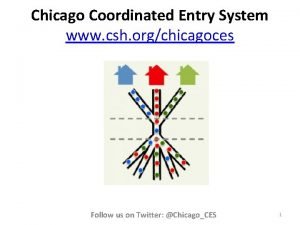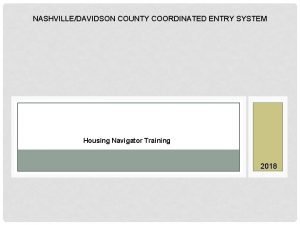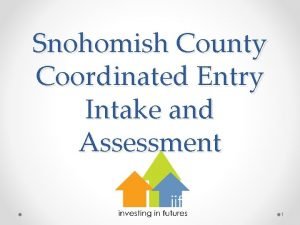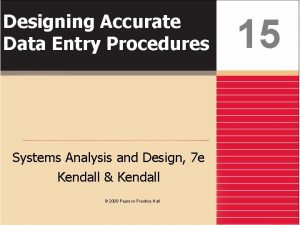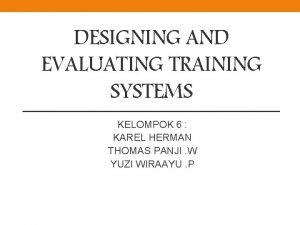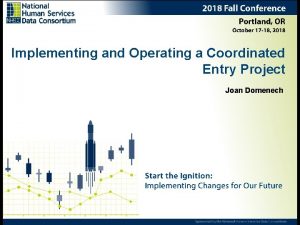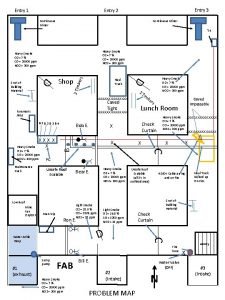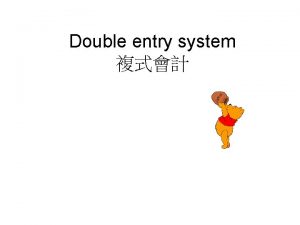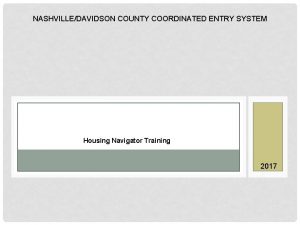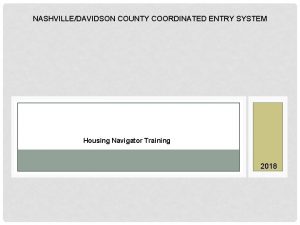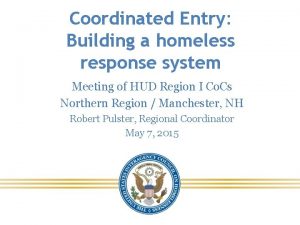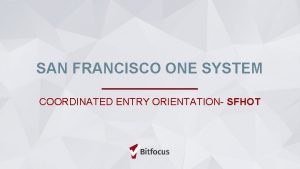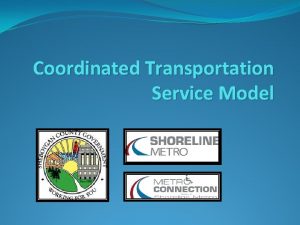Coordinated Entry System Designing and Implementing Coordinated Entry
























- Slides: 24

Coordinated Entry System Designing and Implementing Coordinated Entry in the Alaska Balance of State Co. C Mike Lindsay, ICF Ryan Burger, ICF Christine Nguyen, ICF Carrie Collins, Alaska Housing Finance Corporation Brian Wilson, Alaska Coalition on Housing and Homelessness

Agenda § Welcome and Introductions § Overview of Coordinated Entry Background § Introduction to Components of Coordinated Entry § Review of Planning Guide and Process § Expectations and Next Steps: Local Leadership 2/27/2021 2

Welcome and Introductions ICF proprietary and confidential. Do not copy, distribute, or disclose. 2/27/2021 3

Welcome and Introductions § Your Presenters § § § Brian Wilson, Executive Director, Alaska Coalition on Housing and Homelessness Carrie Collins, Alaska Housing Finance Corporation Mike Lindsay, HUD Technical Assistance Provider at ICF Ryan Burger, HUD Technical Assistance Provider at ICF Christine Nguyen, HUD Technical Assistance Provider at ICF § Webinar Logistics § § § This webinar is being recorded Slides will be available after the webinar All attendees are currently muted To submit a question: Type your question in the Q&A box (select either “all participants” or “all panelists”) To ask a question: Raise your hand you will be unmuted (functionality only available for those who have called in via phone) § Please submit any technical issues related to Web. Ex in the chat box 2/27/2021 4

What You Can Expect From the Committee § Forming CES Planning Committee at the Co. C § Developing CES Policies and Procedures/Written Standards § Addressing the use of HMIS in coordination with other Co. Cs § Researching other models of CES in Balance of State Co. Cs § Implementing statewide CES standards § Aligning CES system design with HUD’s requirements § Learning from local stakeholders about resources and how to implement the Coordinated Entry System across the Co. C § Next Steps: § Identify the current status of regional homeless service coordination § Develop a schedule and process for the CE Planning Committee § Get started 2/27/2021 5

Overview of Coordinated Entry Background ICF proprietary and confidential. Do not copy, distribute, or disclose. 2/27/2021 6

Call to Action of the HEARTH Act § The call to action of the HEARTH Act § “Transform homeless services into crisis response systems that prevent and end homelessness and rapidly return people who experience homelessness to stable housing. ” § Purpose of the HEARTH Act § Consolidate homeless assistance programs § Codify the Continuum of Care planning process § Establish a goal of ensuring that families who become homeless return to permanent housing within 30 days § Establishing a Coordinated Entry System has been a requirement since 2012 (Co. C Program interim rule) § HUD has established a deadline of January 23, 2018 for Co. Cs to establish or update their Coordinated Entry System (Notice CPD-17 -01) 2/27/2021 7

Moving to a Systems Approach To Ending Homelessness § Moving from: § § § § § Agency Performance Unique Agency Intake Planning in Silos Haphazard Decisions Housing Readiness Automatic Project Renewal Outdated Program Models Housing the Next In Line My Program ICF proprietary and confidential. Do not copy, distribute, or disclose. § Transforming to: § § § § § System Performance Coordinated Entry System Action Plan Data Driven Decisions Housing First Higher Performing Program Funding Best Practices Prioritizing/Serving the most Vulnerable Our System 2/27/2021 8

Review of the Key Components and Requirements of Coordinated Entry ICF proprietary and confidential. Do not copy, distribute, or disclose. 2/27/2021 9

Coordinated Entry Process 2/27/2021 10

Coordinated Entry Process: Access § Access points must offer a standardized approach for homeless households seeking assistance § Access points can be a physical site, a phone hotline, or other appropriate type of access model § Access points engage in diversion strategies § Access points refer to prevention and mainstream services when possible § Access points consider safety concerns when making referrals ICF proprietary and confidential. Do not copy, distribute, or disclose. 2/27/2021 11

Coordinated Entry Process: Diversion § Assisting the household avoid homelessness is always the best outcome § Diversion approaches examine the household’s resources, support network, and housing options to avoid homelessness § Case management can address the underlying issues of the housing crisis ICF proprietary and confidential. Do not copy, distribute, or disclose. 2/27/2021 12

Coordinated Entry Process: Prioritization § Prioritization ensures that scarce housing resources are used effectively § Chronically homeless households and those with high needs and barriers are prioritized for service § Prioritization reflects the unique needs of the local homeless population § Prioritization approach is fair and transparent ICF proprietary and confidential. Do not copy, distribute, or disclose. 2/27/2021 13

Coordinated Entry Process: Referral Process § Vacancies in a program are filled through the Coordinated Entry System § Households are referred to programs for which they are eligible § Client choice informs the referral process § Programs use a Housing First approach to lower barriers and ensure that high-need households receive assistance ICF proprietary and confidential. Do not copy, distribute, or disclose. 2/27/2021 14

Coordinated Entry Process: Housing Placement § Programs accept households from the Coordinated Entry System § Clients are not screened out of a program because of real or perceived barriers related to housing or services § Equal access and fair housing protections ensure households are not steered to any particular program § Households achieve permanent housing as quickly as possible ICF proprietary and confidential. Do not copy, distribute, or disclose. 2/27/2021 15

AK Bo. S Planning Process ICF proprietary and confidential. Do not copy, distribute, or disclose. 2/27/2021 16

Coordinated Entry Planning § The following planning guide will be made available to assist regions in considering how to implement a Coordinated Entry System at the state and local level § This planning guide is specifically designed to support your collaborative process for making decisions § Consult HUD’s Notice CPD-17 -01 (Requirements of a Coordinated Entry System) for specific requirements of CES § The Co. C’s Coordinated Entry Planning Committee and ICF are available to assist and support local and regional conversations and decision-making processes 2/27/2021 17

Planning and Stakeholder Consultation § HUD requires Co. Cs to facilitate ongoing planning and stakeholder consultation concerning the implementation of CES § Co. Cs must solicit feedback at least annually from participating projects and from households that participated in CES § Feedback must address both the quality and the effectiveness of the system 2/27/2021 18

Coordinated Entry Planning – Phase 1 § System Design § Planning Considerations – System Review and Mapping Utilizing HMIS data • Utilizing HMIS data identify the current flow and inefficiencies within your current system design • By analyzing local data including entry/exit, length of stay and project utilization rates, communities can begin to identify: » Who are we really serving in our homeless response system? » How are they accessing our services? » Where do homeless individuals and families reside prior to entering the homeless system? » How are we serving homeless individuals and families? » Where do individuals and families go after they leave the homeless system? » How long does our system keep individuals and families in a state of “homelessness”? » Are we efficient? – Identify or develop access models – including capacity and resources • • Physical locations Virtual locations Mobile locations Co-located services/HUBs? » What exists in your communities today that can utilized or expanded? » What needs to be developed to increase fair and equal access to services? 2/27/2021 19

Coordinated Entry Planning – Phase 1 § System Design – Develop assessment phases and structure • • • Initial triage Diversion Preventing screening Non-prioritized emergency services Assessment for prioritization Assessment for eligibility – Develop prioritization list structure • Design a specific and definable set of criteria to apply consistently throughout the Co. C for all populations • Directly written into Polices and Procedures • Consistent with the Co. Cs Written Standards – Develop referral process work flow • Process includes uniform and coordinated referral process for all homeless beds/units • Define eligibility criteria and lower barriers to entry 2/27/2021 20

Coordinated Entry Planning – Phase 2 § Policy Development § Define standardization of policies across regions – identify policies/areas for local flexibility § Define components of Coordinated Entry that require Board involvement/approval § Develop and approve Co. C Written Standards – Eligibility – Prioritization – Level of service – Lower barriers – Increase access to services § Develop requirements for access points – Use of common assessment tool, use of HMIS, timeliness of referrals, engagement in diversion/prevention, hours of operations, etc. § § § Develop/adopt prioritization policies Develop referral policies within and across regions Develop and adopt Housing First requirements Develop referral acceptance/denial and termination policies – client grievance policy Develop performance requirements for participating providers 2/27/2021 21

Coordinated Entry Planning – Phase 3 § Process and Procedure Development § Process and procedures are informed by policies that define how the system operates § Develop an assessment process – Phases of data collection and entry procedures – Potentially at different points in time and by different providers § Develop referral process – Determine how a referral is made – Develop process for providers to accept a referral and provider expectations and requirements – Develop referrals to mainstream resources, both before and after project enrollment § Determine how, when and under what circumstances a recommended assessment, referral or prioritization result can be overridden and by whom § Determine use of case conferences § Establish out-flow/move-up strategies to support client exits from homeless programs § Determine appropriate training supports § Determine the role of an oversight entity/coordinated entry system manager is needed 2/27/2021 22

Coordinated Entry Planning – Phase 4 § HMIS Work Flow Development § § § § Identify what components of coordinated entry will be supported by or managed by HMIS Work with ICA to customize HMIS work flows based on designed CES work flow and phases Identify what client level data will be collected at each phase of the assessment and referral process Determine if additional data elements need to be collected to support CES operation and/or evaluation Develop user guides and material to support HMIS work flows Assess privacy policies and data sharing opportunities/constraints with mainstream providers Assess HMIS licensing and privacy/data sharing agreements with mainstream providers 2/27/2021 23

Next Steps §Questions §Comments §Next Steps 2/27/2021 24
 Designing and implementing brand architecture strategies
Designing and implementing brand architecture strategies Designing and implementing brand architecture strategies
Designing and implementing brand architecture strategies Brand hierarchy tree
Brand hierarchy tree Coordinated entry system chicago
Coordinated entry system chicago Housing navigator training
Housing navigator training Single entry system and double entry system
Single entry system and double entry system Snohomish county coordinated entry
Snohomish county coordinated entry Coordinated entry
Coordinated entry Designing accurate data entry procedures
Designing accurate data entry procedures Explanation of code
Explanation of code Single entry system meaning
Single entry system meaning Conversation
Conversation Implementing strategies management and operations issues
Implementing strategies management and operations issues Implementing strategies: management and operations issues
Implementing strategies: management and operations issues Chapter 7 strategic management
Chapter 7 strategic management Tripod of pricing
Tripod of pricing Crm project design and planning process
Crm project design and planning process Implementing strategies management and operations issues
Implementing strategies management and operations issues Ch 7
Ch 7 What is new entry in entrepreneurship
What is new entry in entrepreneurship Major connectors in rpd
Major connectors in rpd Implementing hrd programs
Implementing hrd programs Implementing merchandise plans
Implementing merchandise plans Essential elements of portfolio assessment
Essential elements of portfolio assessment Qsen core competencies
Qsen core competencies



